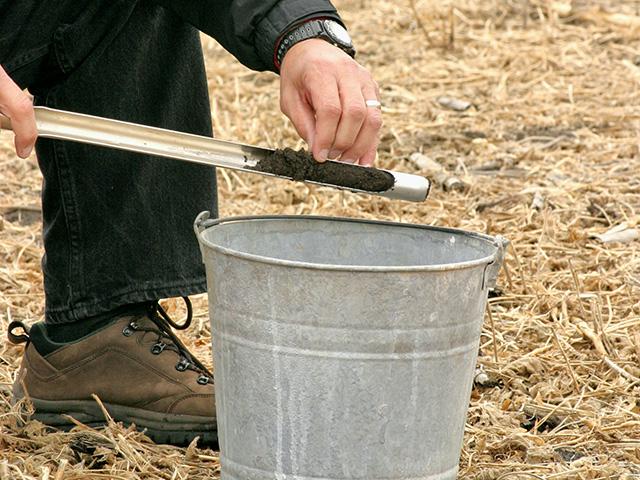Take Time to Test for SCN in October
SCN Action Month: Free Soil Test Kit Available for Soybean Cyst Nematode
JEFFERSON CITY, Mo. (DTN) -- Soybean growers who haven't tested for soybean cyst nematode (SCN) in recent years are being encouraged to assess the pathogen's presence in their fields this fall. Throughout the month of October, dubbed "SCN Action Month," farmers can request a free SCN soil sampling kit.
This is the second year that The SCN Coalition, a group of public universities, checkoff organizations and corporate partners, has joined with BASF to offer the test kits and raise awareness about a pest that causes more than $1.5 billion in damage every year.
"SCN Action Month is really about providing growers with the information needed to make sound, successful agronomic decisions and defend against this really devastating pest," said Troy Bauer, BASF senior technical field representative for seed treatment. "The goal is to encourage growers to take a proactive approach to managing soybean cyst nematodes in their fields."
The parasitic roundworm, which feeds on the roots of soybeans and other legumes, was first detected in the United States in 1954. Sometimes referred to as an invisible enemy, SCN can cause yield losses of 30% or more without the soybean crop showing any above-ground symptoms.
Traditionally, soybean growers have battled this subterranean foe by planting resistant cultivars that reduce SCN's ability to develop and complete its life cycle. The first set of SCN-resistant soybeans was released in 1968, offering a weapon in the war against the pathogen.
However, just as weed species have become herbicide resistant over time with repeated use of the same control methods, nematodes also have adapted. According to The SCN Coalition, about 95% of today's commercial soybean varieties derive their SCN resistance from a single breeding line called PI 88788. After decades of using this same source of resistance, the system is breaking down.
"The bottom line is the nematodes are adapting to what we're planting, so we have to diversify our management plan," said Tamra Jackson-Ziems, a University of Nebraska plant pathologist speaking on behalf of The SCN Coalition at a recent Iowa farm show. "Once you've confirmed it on your farm, you have to decide how you'll manage it."
P[L1] D[0x0] M[300x250] OOP[F] ADUNIT[] T[]
MANAGING SCN
While new varieties with stronger resistance are in development, growers should actively manage their fields for SCN, Jackson-Ziems said. By themselves, the microscopic nematodes can only move inches through the soil. They are more likely to be spread by anything that moves soil, including wind, water and machinery.
When possible, fields with known SCN populations should be worked last to prevent spreading the nematodes to other fields. Power-washing planting and tillage equipment between fields also reduces the risk of transferring infected soil.
While the cysts that contain the nematode's eggs can persist in the soil for years, SCN is parasitic and requires a host. Planting a non-host crop in a field helps break up the SCN life cycle and reduce egg counts.
"Corn is a non-host, and most farmers are planting corn in rotation with soybeans, but there are other options such as alfalfa or sorghum," Jackson-Ziems said. "Growers also need to control winter annual weeds such as henbit, purple dead nettle and shepherd's purse, all of which are SCN hosts."
Rotating the SCN-resistant soybean variety that's planted in a field can also help keep nematodes in check. Most commercial varieties do use PI 88788 for resistance, but other resistant lines have been identified, including one known as Peking. If a Peking variety isn't available for the soybean maturity group grown in a particular region, rotating among different varieties with PI 88788 resistance can slow SCN's adaptation.
A final recommendation from The SCN Coalition is to consider pairing a resistant variety with a nematode-protectant seed treatment.
"If you have SCN, don't just use a seed treatment in place of a resistant variety," said Dylan Mangel, another University of Nebraska plant pathologist. "There's a lot of new products developing in this area."
In 2021, the SCN Action Month campaign received soil samples for testing from farmers in eight states. SCN was detected in 74% of those samples, and more than half contained SCN egg counts considered medium or high. Research has found that higher egg counts correlate to lower soybean yields.
This year, kits will be available to at least the first 500 farmers who request them online. Bauer said growers can also contact their local BASF representative for assistance with soil sampling.
"In hot, dry years, SCN grows and reproduces rapidly, and we had another hot, dry year in the Midwest this year," he said. "We want growers to be aware of what's going on in their field and then manage accordingly."
To order a free SCN test kit, go to https://www.scnactionmonth.com/….
For more information on The SCN Coalition, visit https://www.thescncoalition.com/….
Jason Jenkins can be reached at jason.jenkins@dtn.com
Follow him on Twitter @JasonJenkinsDTN
(c) Copyright 2022 DTN, LLC. All rights reserved.






